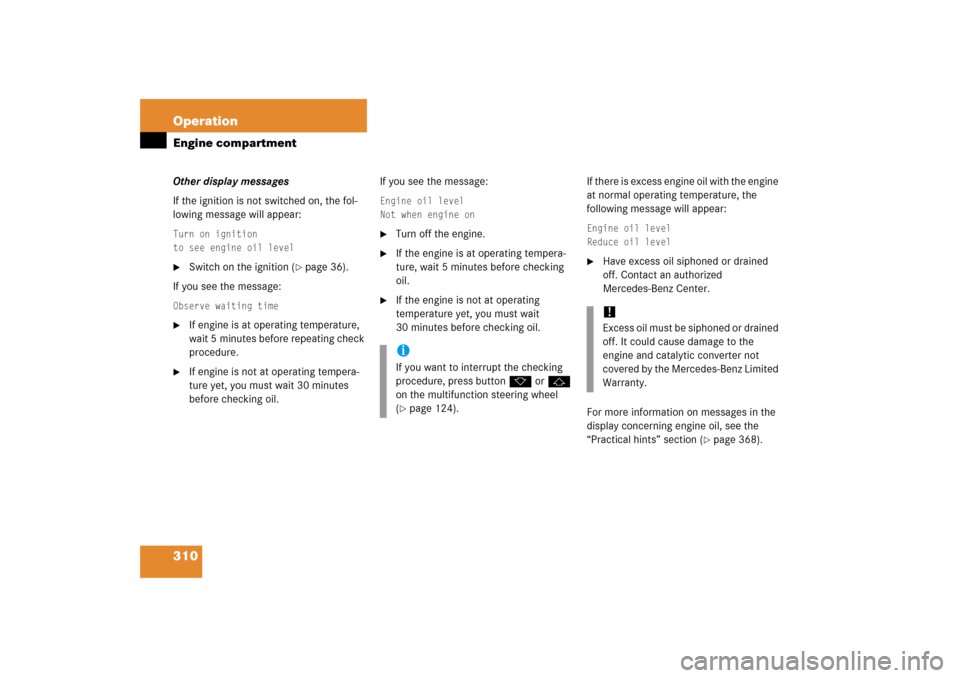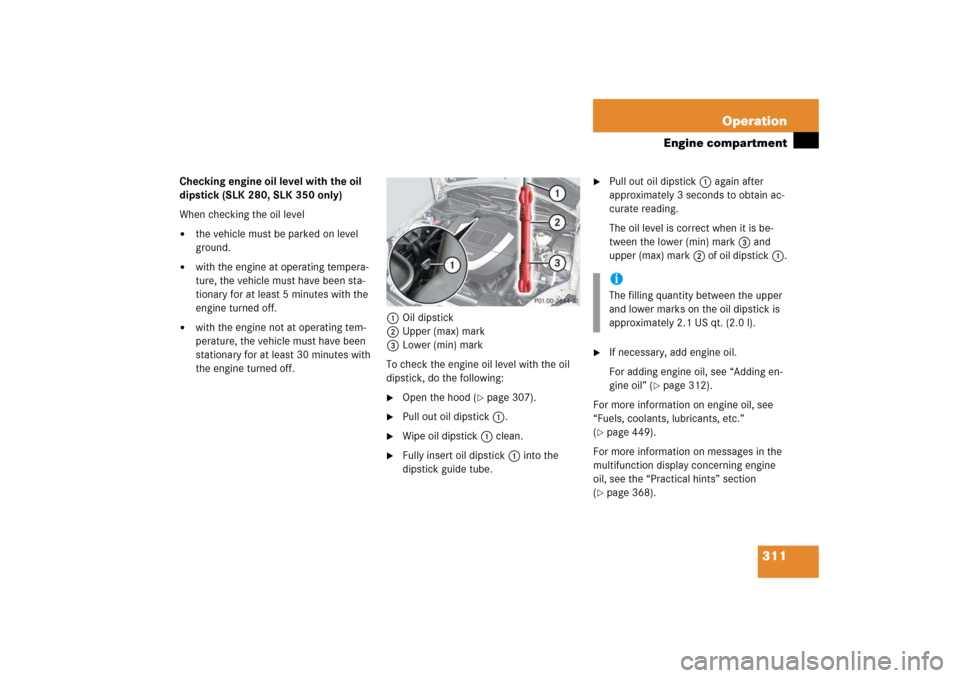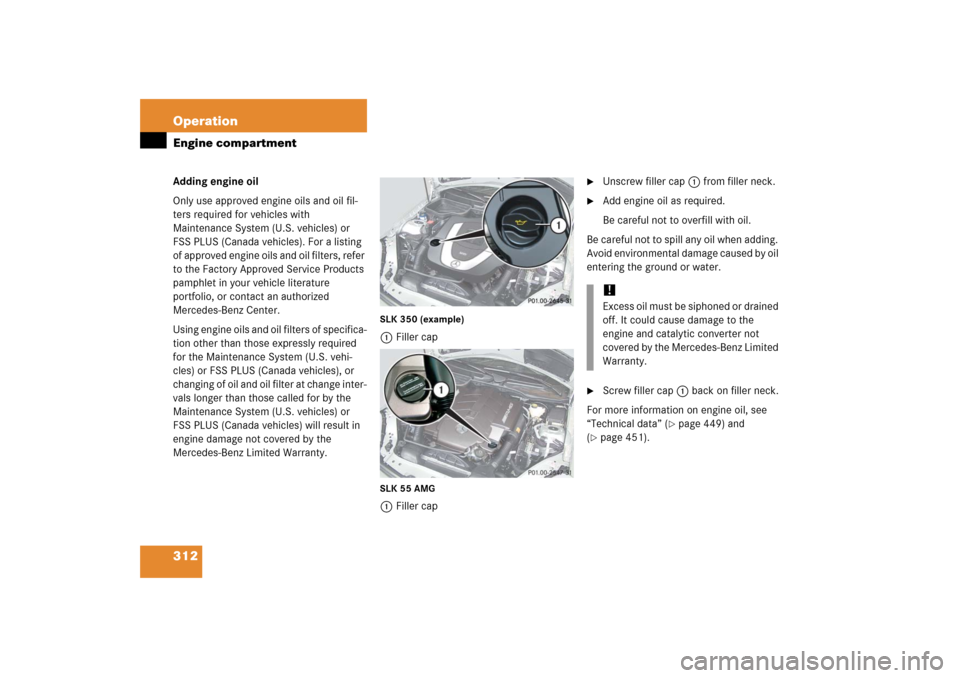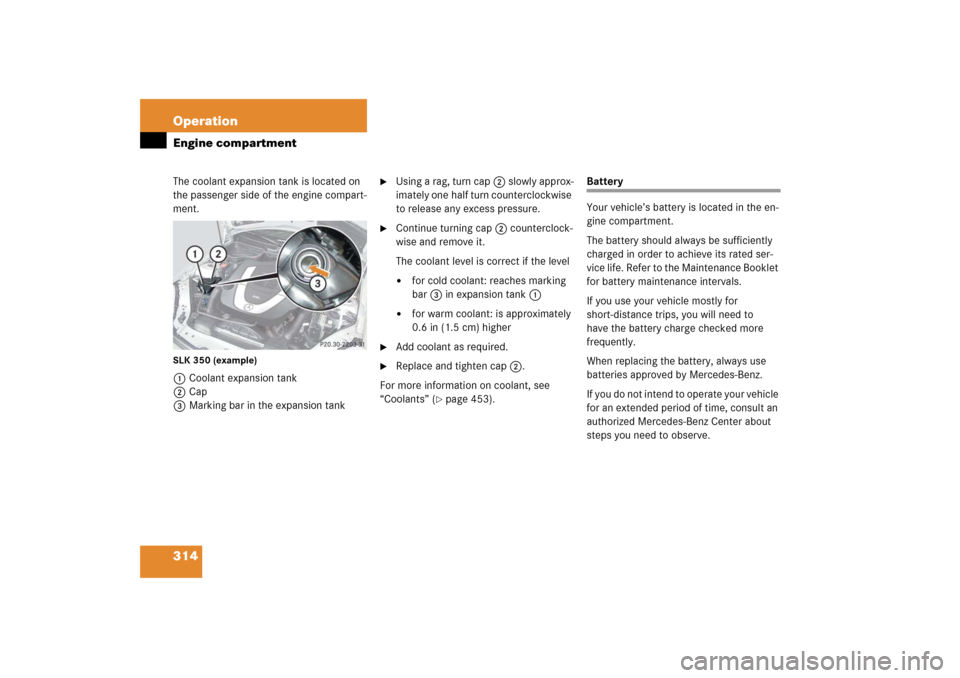Page 311 of 481

310 OperationEngine compartmentOther display messages
If the ignition is not switched on, the fol-
lowing message will appear:Turn on ignition
to see engine oil level�
Switch on the ignition (
�page 36).
If you see the message:
Observe waiting time�
If engine is at operating temperature,
wait 5 minutes before repeating check
procedure.
�
If engine is not at operating tempera-
ture yet, you must wait 30 minutes
before checking oil.If you see the message:
Engine oil level
Not when engine on�
Turn off the engine.
�
If the engine is at operating tempera-
ture, wait 5 minutes before checking
oil.
�
If the engine is not at operating
temperature yet, you must wait
30 minutes before checking oil.If there is excess engine oil with the engine
at normal operating temperature, the
following message will appear:
Engine oil level
Reduce oil level�
Have excess oil siphoned or drained
off. Contact an authorized
Mercedes-Benz Center.
For more information on messages in the
display concerning engine oil, see the
“Practical hints” section (
�page 368).
iIf you want to interrupt the checking
procedure, press buttonk orj
on the multifunction steering wheel
(�page 124).
!Excess oil must be siphoned or drained
off. It could cause damage to the
engine and catalytic converter not
covered by the Mercedes-Benz Limited
Warranty.
Page 312 of 481

311 Operation
Engine compartment
Checking engine oil level with the oil
dipstick (SLK 280, SLK 350 only)
When checking the oil level�
the vehicle must be parked on level
ground.
�
with the engine at operating tempera-
ture, the vehicle must have been sta-
tionary for at least 5 minutes with the
engine turned off.
�
with the engine not at operating tem-
perature, the vehicle must have been
stationary for at least 30 minutes with
the engine turned off.1Oil dipstick
2Upper (max) mark
3Lower (min) mark
To check the engine oil level with the oil
dipstick, do the following:
�
Open the hood (
�page 307).
�
Pull out oil dipstick1.
�
Wipe oil dipstick1 clean.
�
Fully insert oil dipstick1 into the
dipstick guide tube.
�
Pull out oil dipstick1 again after
approximately 3 seconds to obtain ac-
curate reading.
The oil level is correct when it is be-
tween the lower (min) mark3 and
upper (max) mark2 of oil dipstick1.
�
If necessary, add engine oil.
For adding engine oil, see “Adding en-
gine oil” (
�page 312).
For more information on engine oil, see
“Fuels, coolants, lubricants, etc.”
(
�page 449).
For more information on messages in the
multifunction display concerning engine
oil, see the “Practical hints” section
(�page 368).iThe filling quantity between the upper
and lower marks on the oil dipstick is
approximately 2.1 US qt. (2.0 l).
Page 313 of 481

312 OperationEngine compartmentAdding engine oil
Only use approved engine oils and oil fil-
ters required for vehicles with
Maintenance System (U.S. vehicles) or
FSS PLUS (Canada vehicles). For a listing
of approved engine oils and oil filters, refer
to the Factory Approved Service Products
pamphlet in your vehicle literature
portfolio, or contact an authorized
Mercedes-Benz Center.
Using engine oils and oil filters of specifica-
tion other than those expressly required
for the Maintenance System (U.S. vehi-
cles) or FSS PLUS (Canada vehicles), or
changing of oil and oil filter at change inter-
vals longer than those called for by the
Maintenance System (U.S. vehicles) or
FSS PLUS (Canada vehicles) will result in
engine damage not covered by the
Mercedes-Benz Limited Warranty.
SLK 350 (example)1Filler capSLK 55 AMG1Filler cap
�
Unscrew filler cap1 from filler neck.
�
Add engine oil as required.
Be careful not to overfill with oil.
Be careful not to spill any oil when adding.
Avoid environmental damage caused by oil
entering the ground or water.
�
Screw filler cap1 back on filler neck.
For more information on engine oil, see
“Technical data” (
�page 449) and
(
�page 451).!Excess oil must be siphoned or drained
off. It could cause damage to the
engine and catalytic converter not
covered by the Mercedes-Benz Limited
Warranty.
Page 315 of 481

314 OperationEngine compartmentThe coolant expansion tank is located on
the passenger side of the engine compart-
ment.SLK 350 (example)1Coolant expansion tank
2Cap
3Marking bar in the expansion tank
�
Using a rag, turn cap2 slowly approx-
imately one half turn counterclockwise
to release any excess pressure.
�
Continue turning cap2 counterclock-
wise and remove it.
The coolant level is correct if the level �
for cold coolant: reaches marking
bar3 in expansion tank1
�
for warm coolant: is approximately
0.6 in (1.5 cm) higher
�
Add coolant as required.
�
Replace and tighten cap2.
For more information on coolant, see
“Coolants” (
�page 453).
Battery
Your vehicle’s battery is located in the en-
gine compartment.
The battery should always be sufficiently
charged in order to achieve its rated ser-
vice life. Refer to the Maintenance Booklet
for battery maintenance intervals.
If you use your vehicle mostly for
short-distance trips, you will need to
have the battery charge checked more
frequently.
When replacing the battery, always use
batteries approved by Mercedes-Benz.
If you do not intend to operate your vehicle
for an extended period of time, consult an
authorized Mercedes-Benz Center about
steps you need to observe.
Page 317 of 481

316 OperationEngine compartmentDuring all seasons, add MB Windshield
Washer Concentrate “S” to water. Premix
the windshield washer fluid in a suitable
container.
�
Pull cap upward using latch until it
opens.
�
Refill the reservoir with MB Windshield
Washer Concentrate and water (or
commercially available premixed wind-
shield washer solvent/antifreeze, de-
pending on ambient temperatures).
Always use washer solvent/antifreeze
where temperatures may fall below
freezing point. Failure to do so could re-
sult in damage to the washer sys-
tem/reservoir.
�
Push cap down until it engages.For more information, see “Windshield
washer system and headlamp cleaning
system*” (
�page 456).
Warning!
G
Washer solvent/antifreeze is highly flamma-
ble. Do not spill washer solvent/antifreeze
on hot engine parts, because it may ignite
and burn. You could be seriously burned.
!Only use washer fluid which is suitable
for plastic lenses. Improper washer flu-
id can damage the plastic lenses of the
headlamps.
Page 319 of 481

318 OperationTires and wheelsTire care and maintenance
Regularly check your tire inflation pressure
at least once a month. For more informa-
tion on checking tire inflation pressure,
see “Recommended tire inflation pres-
sure” (
�page 327).Tire inspection
Every time you check your tire inflation
pressure, you should also inspect your
tires for the following:
�
excessive treadwear (
�page 319)
�
cord or fabric showing through the
tire’s rubber
�
bumps, bulges, cuts, cracks or splits in
the tread or side of the tire
Replace the tire if you find any of the above
conditions.
Make sure you also inspect the spare tire
periodically for condition and inflation.
Spare tires will age and become worn over
time even if never used, and thus should be
inspected and replaced when necessary.Life of tire
The service life of a tire is dependent upon
varying factors including but not limited to:
�
Driving style
�
Tire inflation pressure
�
Distance driven
Warning!
G
Regularly check the tires for damage. Dam-
aged tires can cause tire inflation pressure
loss. As a result, you could lose control of
your vehicle.
Worn, old tires can cause accidents. If the
tire tread is badly worn, or if the tires have
sustained damage, replace them.
Warning!
G
Tires and spare tire should be replaced after
six years, regardless of the remaining tread.
Page 323 of 481

322 OperationTires and wheelsLoading Information placard (Example A),
locate the statement “The combined
weight of occupants and cargo should
never exceed XXX kilograms or XXX lbs.”
on this placard. The combined weight of all
occupants, cargo / luggage and trailer
tongue load (if applicable) should never
exceed the weight referenced in that
statement.
Placard (Example B)
1Load limit information on the Vehicle
Tire Information placardThe placard showing the load limit informa-
tion is located on the driver’s door B-pillar.
If your vehicle is equipped with the Vehicle
Tire Information placard (Example B),
locate the heading “Vehicle Capacity
Weight” on this placard. The combined
weight of all occupants, cargo/luggage
and trailer tongue (if applicable) should
never exceed the weight listed next to
vehicle capacity weight.Seating capacity
The seating capacity gives you important
information on the number of occupants
that can be in the vehicle. Your vehicle is
equipped with either placard Example A or
placard Example B located on the driver’s
door B-pillar (
�page 321).
iData shown on placard examples are
for illustration purposes only. Seating
data are specific to each vehicle and
may vary from data shown in the illus-
trations below. Refer to placard on ve-
hicle for actual data specific to your
vehicle.
Page 325 of 481
324 OperationTires and wheelsStep 6 (if applicable)�
If your vehicle will be towing a trailer,
load from your trailer will be trans-
ferred to your vehicle. Consult this
manual to determine how this reduces
the available cargo and luggage load
capacity of your vehicle (
�page 326).
The following table shows examples on
how to calculate total and cargo load
capacities with varying seating configura-
tions and number and size of occupants.
The following examples use a load limit
of 1500 lbs. This is for illustration
purposes only. Make sure you are using
the actual load limit for your vehicle stated
on the vehicle’s placard (
�page 321).
��